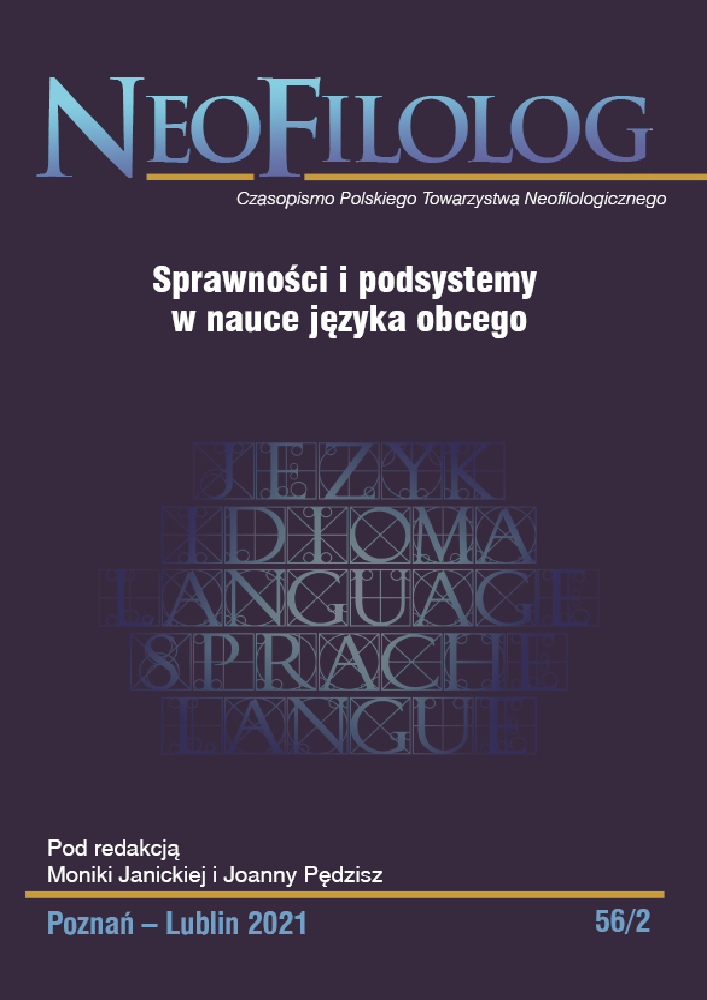Abstract
Sentence adverbials build a multidimensional constituent in many languages, i.e. they can, among others, modify the meaning of the entire sentence, emphasize a particular element in it, or build the coherence in texts. Due to the multifaced character of this linguistic phenomenon the acquisition of it in foreign language learners can be a complex process. The learner is not only faced with a variety of different words and phrases that can be used in order to deliver a complementary information in the text, but also, depending on the structural requirements of the specific language, has to learn to put this constituent in the correct place in the sentence. In present paper the use of sentence adverbials in Polish learners od Swedish will be presented. The data considered in the analysis comprises two types of texts: a summary of an expository text and a narrative. The results show that foreign language learners at the intermediate stage of the language use a broad repertoire of sentence adverbials and place them in appropriate contexts. In narratives modal expressions predominate, while in summaries connectives and intensifiers are used more often. The learners can place sentence adverbials correctly in the sentence, especially in main clauses. However, the word order in dependent clauses when other sentence adverbials occur, except for sentences with the negation inte, is still under development.
References
Åström, M. (2006), Språkporten - för svenska som andraspråk A och B. Lund: Studentlitteratur.
Biber D. i in. (1999), Longman Grammar of Spoken and Written English. Harlow: Longman.
Bolander M. (1988), „Nu jag hoppas inte så mycke”. Om inversion och placering av negation och adverb i svenska som andraspråk, (w:) Hyltenstam K., Lindberg I. (red.), Första symposiet om svenska som andraspråk. Stockholm: Centrum för tvåspråkighetsforskning, s. 203−214.
Bolander M. (2005), Funktionell svensk grammatik. Stockholm: Liber.
Coste D. i in. (2003), Europejski system opisu kształcenia językowego : uczenie się, nauczanie, ocenianie. Warszawa: CODN.
Grochowski M. i in. (2014), Słownik gniazdowy partykuł polskich. Kraków: Polska Akademia Umiejętności.
Hartmann R., Stork F.C. (1976), Dictionary of language and linguistics. London: Applied Science Publ.
Holm B., Nylund E. (1993), Deskriptiv svensk grammatik. Stockholm: Liber.
Hyltenstam K. (1978), Variation in interlanguage syntax. Lund: Department of Linguistics.
Kowal I. (2020), Satsadverbial i svenskundervisningen — en läroboksanalys. „Scandinavian Philology”, nr 18(1), s. 56−71.
Laskowski R. (1999), Zagadnienia ogólne morfologii, (w:) Grzegorczykowa R., Laskowski R., Wróbel H. (red.), Gramatyka współczesnego języka polskiego. Morfologia. Warszawa: Wydawnictwo Naukowe PWN, s. 27−50.
Levy Scherrer P., Lindemalm K. (2008), Rivstart B1 + B2. Textbok. Stockholm: Natur och kultur.
Lindholm H. (1997), Svensk grammatik. Svenska som främmande språk. Lund: Kursverksamhetens förlag.
Lindström E., Lubinska D. (2019), En deskriptiv longitudinell studie av konnektorbruk i nybörjarsvenska hos vuxna inlärare, (w:) Ljung Egeland B. i in. (red.), Klassrumsforskning och språk(ande). Classroom research and language/lan-guaging. Rapport från ASLA-symposiet i Karlstad, 12–13 april, 2018. Papers from the ASLA symposium in Karlstad, 12–13 April, 2018. Karlstad: Karlstads universitet, s. 61−87.
Mirowicz A. (1948), O partykułach, ich zakresie i funkcji. „Biuletyn PTJ”, nr 8, s. 134−148.
Pienemann M., Håkansson G. (1999), A Unified Approach toward the Development of Swedish as L2. A Processability Account. „Studies in Second Language Acquisition”, nr 21(3), s. 383−420.
Saloni Z. (1974), Klasyfikacja gramatyczna leksemów polskich. „Język polski”, nr 14(2), s. 93−101.
Strutyński J. (2002), Gramatyka polska: wprowadzenie, fonetyka, fonologia, morfologia, składnia (wyd. 5). Kraków: Wydawnictwo Tomasz Strutyński.
Swan M. (2005), Practical English usage. Oxford: Oxford University Press.
Szober S. (1923), Gramatyka języka polskiego. Lwów-Warszawa: Książnica Polska.
Świątkowska M. (2014), O partykułach inaczej. Kilka uwag o problemach terminologicznych, (w:) Bednarczuk L. i in. (red.), Linguistique romane et linguistique indo-européenne : mélanges offerts à Witold Mańczak à l’occasion de son 90e anniversaire. Kraków: Uniwersytet Jagielloński. Instytut Filologii Romańskiej, s. 445−450.
Teleman U. i in. (1999), Svenska Akademiens grammatik. 4, Satser och meningar. Stockholm: Norstedts Ordbok.
Thomson A.J., Martinet A.V. (2001), A practical English grammar. Oxford: Oxford University Press.
Vaakanainen V. (2018), Konnektorbrukets utveckling i finska inlärares L2-svenska, (w:) Sköldberg E. i in. (red.), Svenskans beskrivning 35: Förhandlingar vid trettiofemte sammankomsten Göteborg 11–13 maj 2016. Göteborg: Göteborgs Universitet, s. 341−353.
Wajszczuk J. (2005), O metatekście. Warszawa: Katedra Lingwistyki Formalnej UW.
License
Copyright (c) 2021 Iwona Kowal

This work is licensed under a Creative Commons Attribution-NoDerivatives 4.0 International License.
Authors
Authors of texts accepted for publication in Neofilolog are required to complete, sign and return to the Editorial team’s office the Agreement for granting a royalty-free license to works with a commitment to grant a CC sub-license.
Under the agreement, the authors of the texts published in Neofilolog grant Adam Mickiewicz University in Poznań a non-exclusive, royalty-free license and authorize the use of Attribution-NoDerivatives 4.0 International (CC BY-ND 4.0) Creative Commons sub-license.
The authors retain the right to the free disposal of the work.
Users
Interested Internet users are entitled to use works that have been published in Neofilolog since 2017, under the following conditions:
▪ attribution – obligation to provide, together with the distributed work, information about the authorship, title, source (link to the original work, DOI) and the license itself.
▪ no derivatives – the work must be preserved in its original form. Without the author's consent, it is not possible to distribute the modified work in the form of translations, publications, etc.
Copyrights are reserved for all texts published since 2017.
Miscellaneous
Adam Mickiewicz University in Poznań retains the property right as a whole (layout, graphic form, title, cover design, logo etc.).

